
MAY CONTAIN NUTS

Search Shorpy
SHORPY ART

Framed or unframed, desk size to sofa size, printed by us in Arizona and Alabama since 2007. Explore now.
Join and Share
Ad-Free Shorpy
Shorpy is funded by you. Patreon contributors get an ad-free experience.
Learn more.

Recent comments
- Baldwin 62303
- Baldwin VO-1000
- Cold
- No expense spared
- Tough Guys
- Lost in Toyland
- And without gloves
- If I were a blindfolded time traveler
- Smoke Consumer Also Cooks
- Oh that stove!
- Possibly still there?
- What?!?
- $100 Reward
- Freeze Frame
- Texas Flyer wanted
- Just a Year Too Soon
- WWII -- Replacing men with women at the railroad crossing.
- Yes, Icing
- You kids drive me nuts!
- NOT An Easy Job
- I wonder
- Just add window boxes
- Icing Platform?
- Indiana Harbor Belt abides
- Freezing haze
- Corrections (for those who care)
- C&NW at Nelson
- Fallen Flags
- A dangerous job made worse
- Water Stop
Member Photos
The Shorpy
Print Emporium
Print Emporium
Search Shorpy
Search results -- 30 results per page
- Gray Acres: 1937
- ... Joe Kramer, farmer near Williston, North Dakota." Photo by Russell Lee for the Resettlement Administration. View full size.
Hope Joe got ... Posted by Dave - 08/27/2013 - 3:36pm -
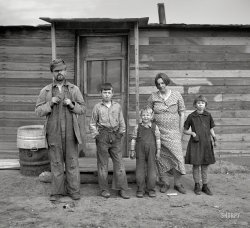
- Inflationary Pressure: 1936
- ... tire in Abbeville, Louisiana." 35mm nitrate negative by Russell Lee for the Farm Security Administration. View full size.
Look at the ... Posted by Dave - 08/13/2013 - 3:39pm -
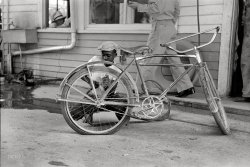
- Summer Internees: 1942
- ... farm workers swimming." Medium format nitrate negative by Russell Lee for the Farm Security Administration. View full size.
Beam me up! ... Posted by Dave - 08/21/2012 - 8:34pm -
![Summer Internees: 1942 July 1942. "Rupert, Idaho. Former CCC camp now under FSA management. Japanese-American farm workers swimming." Medium format nitrate negative by Russell Lee for the Farm Security Administration. View full size.
Beam me up!The an on the left could be a relative of George Takei. He spent time in an internment camp as a child.
I hope they found some funHard to be happy when your family is interned for no other reason than being Japanese. Unless I have my facts wrong. Good photo though!!
They seem relatively happydespite being interred for no real good reason. I wonder if they were asked to smile for the camera.
[You might want to check the difference between "interred" and "interned." - Dave]
The campsA former Japanese American co-worker said that from her personal experience once people arrived at the internment camps friendships were made and people generally made the best of a terrible situation. She said she met her future husband while there and that her family was able to buy a few simple comforts of home from the Sears and Montgomery Ward catalogues. Many of the San Diego children regularly corresponded with Miss Breed, a kindly downtown librarian who later published some of those letters in a book entitled "Dear Miss Breed." She remained close to some of those former children the rest of her life.
Bathing BeautiesFinally some bathing beauties I can appreciate. hubba hubba!
(The Gallery, Relocation Camps, Russell Lee, Swimming, WW2)](https://www.shorpy.com/files/images/SHORPY_8c32564u.thumbnail.jpg)
- Bingo: 1938
- ... Louisiana." View full size. 35mm negative by Russell Lee.
Bingo Then What? Just one bingo card each..no colorful marking ... Posted by Dave - 09/11/2011 - 12:53pm -
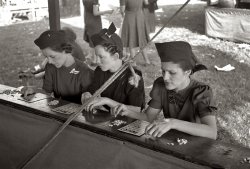
- Easter Sunday: 1941
- ... in South Side Chicago. View full size. Photograph by Russell Lee. Observe, young people of today, how the young people of yesterday dressed: ... Posted by Dave - 09/07/2011 - 9:06pm -
![Easter Sunday: 1941 Easter Sunday, April 1941. Boys waiting for the processional at an Episcopal church in South Side Chicago. View full size. Photograph by Russell Lee. Observe, young people of today, how the young people of yesterday dressed: Up.
ProcessionalThat's exactly what it is.
QuestionWhat is a processional? Sounds like a march with religious meaning, but I'm not sure.
[Good question. Pics below. - Dave]
(The Gallery, Chicago, Russell Lee)](https://www.shorpy.com/files/images/8a29969u.thumbnail.jpg)
- Slick Depot: 1940
- ... of Slick, Oklahoma." Medium format acetate negative by Russell Lee for the Farm Security Administration. View full size.
Okie names ... Posted by Dave - 07/18/2018 - 1:44pm -
![Slick Depot: 1940 February 1940. "Abandoned railway station, now used as a church, in the oil ghost town of Slick, Oklahoma." Medium format acetate negative by Russell Lee for the Farm Security Administration. View full size.
Okie namesWell, I thought I had heard them all but that's a new one! I know of Gotebo and Bug Tussle (I had to check the spelling here) and I once lived near Fanshawe and Red Oak. The last two were just "blink and you miss them" spots 20 years ago.
[Named for oilman Thomas B. Slick. - Dave]
The building today!
Still there- - still a church, still slick.
Fire and brimstoneIt appears that the Reverend went a little heavy on the fire part, enough to buckle the right side of the roof and bow the guttering, which by the way, needs another downspout on that deformed section.
Nice punSlick seems like the perfect name for an oil town.
... but why is there a "DANGEROUS" sign beside the church on the road?
[It's one of the danger signs of whatever. - Dave]
Full stopCareful, Tom Slick. Watch that dangerous Slick spot as you zoom by in your Thunderbolt Grease Slapper.
Oklahoma-SouthwesternEdson says the Oklahoma-Southwestern Railway was active from 1920 to 1930; Moody's says it was dismantled in January 1930. Ran 24 miles southeast from the Frisco main at Bristow to a dead end at Nuyaka. T.B. Slick was president.
Amazing GraceMaybe she's a descendant of the town's namesake?
(The Gallery, Railroads, Russell Lee, Small Towns)](https://www.shorpy.com/files/images/SHORPY-8b23847a.thumbnail.jpg)
- Fill In the Blank: 1939
- ... Mississippi." View full size. 35mm nitrate negative by Russell Lee for the Farm Security Administration.
Wines, Beer and ... Beyond. ... Posted by Dave - 06/02/2008 - 4:09pm -
![Fill In the Blank: 1939 January 1939. "Beer hall. Mound Bayou, Mississippi." View full size. 35mm nitrate negative by Russell Lee for the Farm Security Administration.
Wines, Beer and ... Beyond.
Mound BayouI worked around Mound Bayou and the surrounding communities from 1985 until 1990.
This is what most of the small Delta town main streets still looked like even then. Little had changed between 1850, 1939 and 1990. Most of the little Delta towns were time capsules.
I don't know if anything has changed since, but I see highway 61 is at least now 4 lane.
Juking"Juking? Oh! Well, that's when you get in a car, which is preferably open in any kind of weather. And then you drink a little bit and you drive a little bit, and then you stop and you dance a little bit with a jukebox. And then you drink a little bit more and you drive a little bit more, you stop and you dance a little bit more to another juke box! And then you stop dancing and you just drink and you drive. And then, you stop driving."
-- Tennessee Williams, "Orpheus Descending"
Ole MissI guess Mississippi wasn't dry in 1939. It was when I was at Biloxi in 1958 and 59, except for Harrison County of course.
Full FrontalI love the stark frontality of this view. It also looks like the sign-painter who did the "Royal Club" sign was influenced by the lettering style of the famous Coca-Cola logo, as seen next door.
[Note that the sign painter signed his work. - Dave]
What 'Mound Bayou' said...When my family moved to the South in the 60's you could easily still find places like this even in larger cities - even into the early 80s. Too poor to tear them down, too poor to build new - ancient structures abided in many forms from homes, factories, and juke joints like these.
I've passed through the town at least once. Mound Bayou was founded by two former slaves of Joe Davis, the older brother of Jefferson Davis:
From http://www.moundbayou.org/
Shortly after the war in 1867, the Montgomery’s entered an agreement with Joe Davis for the purchase of the plantations, consisting of four thousand acres, for $300,000 at 6% per annum. Joe Davis wished that the plantations would be managed by the Montgomery’s as a home and for the benefit of their former slaves.
Miss. Liquor SalesMississippi did not end statewide prohibition until 1962; however, each county had its own saloons and bootleggers who operated with the complicity of the police.
After 1962, there was the "local option," in which a town could be dry and the county wet, or vice versa. Lauderdale County was dry in 1979; Meridian, the county seat, was wet.
Until 1984 when national drinking age was raised to 21, MS was 18 for beer and 21 for everything else. So some towns were wet for liquor and dry for beer ... Starkville, home of MSU, was one.
Royal ClubSmall 19th-century wood-frame buildings still stand in the poorer districts of Mississippi's cities, towns, and wide spots in the road. The most comprehensive example of this that I have found is the western neighborhoods Jackson, the state capital. The divide between the haves and have-nots never really disappeared here.
Watch your step...The first one is a doozy, building on the right.
--------------------
Jeffery Wright
planetfallstudios.com
Mound BayouMy grandparents lived not far from Mound Bayou and I visited them often, in the 60s and 70s. Most little Delta towns in those days were controlled by the whites, no matter what the population ratio was, but Mound Bayou was known as the town of, by, and for African-Americans, according to the white talk of the day. I drove through a number of times, but don't recall it looking significantly different from Drew or Ruleville or any of the other towns in that area.
New and ImprovedNow in living color! Click to enlarge.
(The Gallery, Rural America, Russell Lee, Stores & Markets)](https://www.shorpy.com/files/images/8a25121u.thumbnail.jpg)
- High Lonesome: 1940
- ... at Silverton, Colorado." Medium format acetate negative by Russell Lee for the Farm Security Administration. View full size.
"The ... Posted by Dave - 08/12/2020 - 4:24pm -
![High Lonesome: 1940 September 1940. "Rooming house and lodge hall at Silverton, Colorado." Medium format acetate negative by Russell Lee for the Farm Security Administration. View full size.
"The Lodge"The Lodge is an Edwardian style boutique hotel offering luxurious furnishings and opulent amenities to those lucky enough to book a stay. Once a secret Masonic Lodge Hall, the Lodge is now a plush collection of stately Suites and Grande Suites. Come stay with us and allow yourself to be pampered in the lap of luxury.
https://www.historicsilvertonlodge.com/
Dave --- best comeback yet !
No secrets hereTake it from a Master Mason. Mason's Masons are not a secret society. We are part of the community and benefactors to the same. There are many such misrepresentations and generally we do not dispute them as it does no good and only causes arguments.
2B1ASK1.
Secret?All those Masonic signs on the corner of the building are not doing a very good job of keeping knowledge of the lodge there to themselves..
I Can't Tell from HereIs that Opie Taylor or Dennis "the Menace" Mitchell out in front?
[Ask Mr. Wilson! - Dave]
(The Gallery, Frontier Life, Kids, Russell Lee, Small Towns)](https://www.shorpy.com/files/images/SHORPY-8b26262a.thumbnail.jpg)
- Oklahoma: 1940
- ... party in McIntosh County, Oklahoma." Safety negative by Russell Lee for the Farm Security Administration. View full size.
Happy Days ... Posted by Dave - 09/13/2011 - 2:27pm -
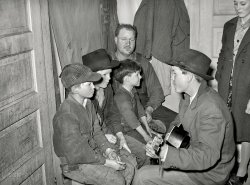
- Be It Ever So Humble: 1938
- ... a parish in northern Louisiana." 35mm nitrate negative by Russell Lee for the Farm Security Administration. View full size.
Insensitive ... Posted by Dave - 02/09/2012 - 12:24pm -
![Be It Ever So Humble: 1938 November 1938. "Shack of day laborer who works in sugarcane fields near New Iberia. He comes from a parish in northern Louisiana." 35mm nitrate negative by Russell Lee for the Farm Security Administration. View full size.
Insensitive commentA set-up for a Laurel & Hardy gag if I ever saw one.
Flanged wheelsare under the hut. Fascinating.
Kids' dreamWhen I was 10 years old, this would have been just the kind of clubhouse / tree house that my friends and I would have loved to have built from scrap lumber, if only our parents would have let us construct it in the back yard.
Jug Band MusicSeeing the washboard in this picture makes me wonder if there isn't a guitar just inside the door ready for an impromptu tune.
[More likely some dirty laundry.]
On the fenceThe laundry's dryin' on the fence, Dave.
[Comment Czar - not Dave, btw - acknowledges your observation, but speculates our fellow may have separated out his whites and still needs to do his union suit.]
Early WinnebagoPrototype motor home?
About those flanged wheelsI was recently reading an article on the sawmill towns of western Louisiana. A large part of the article was devoted to the types of company housing used in the towns.
One type of housing used in the temporary logging camps [called "front camps"] was a simple shack, or series of shacks, mounted on railroad flat cars, to provide accomodations for the workers in the camps. The shacks would simply be wheeled into place on the company rail line and then withdrawn to the next location once all the timber had been cut out.
Looks like this might have been one of those "mobile homes" left over from the sawmill days, since by 1938 most of the western Louisiana timber lands were a wasteland of cut-over stumps.
(The Gallery, Agriculture, Russell Lee)](https://www.shorpy.com/files/images/SHORPY_8a24815a.thumbnail.jpg)
- The Simple Life: 1936
- ... View full size. Medium format nitrate negative by Russell Lee.
Shelf above the counter Can you decipher what's stamped on the ... Posted by Dave - 03/02/2013 - 3:00pm -
![The Simple Life: 1936 December 1936. "Washstand in house occupied by married hired hand and his wife. Harry Madsen farm near Dickens, Iowa. Three hundred sixty acres, owner-operated." View full size. Medium format nitrate negative by Russell Lee.
Shelf above the counterCan you decipher what's stamped on the shelf hanging under the mirror?
["Comb brush" - Dave]
Wow.For some reason, this simple vignette just made my day...it's beautiful. The polka-dot oilcloth to protect the wallpaper, the pretty little mirror, the special shelf for the comb. Love it. Again, just because you're poor doesn't mean you have to live in squalor.
(The Gallery, Rural America, Russell Lee)](https://www.shorpy.com/files/images/SHORPY_8b38529u.thumbnail.jpg)
- Neither Snow Nor Mud: 1940
- ... of Nevada County, California." Acetate negative by Russell Lee. View full size.
Muck Truck This is a 1920s Dodge Commercial ... Posted by Dave - 08/30/2018 - 2:12pm -
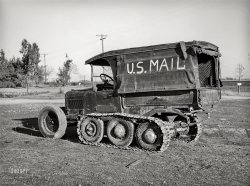
- Apache Beer: 1940
- ... Meat Market in the Holz Building on Naco Road. Photo by Russell Lee. View full size.
Local Brews Arizona Brewing Co., founded when ... Posted by Dave - 08/15/2018 - 6:09pm -
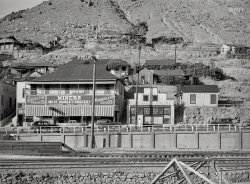
- Silverton Jail: 1940
- ... Juan County, Colorado." Medium format acetate negative by Russell Lee for the Farm Security Administration. View full size.
Bars ... Posted by Dave - 04/30/2020 - 2:19pm -
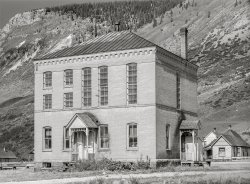
- Pie Town Barbecue: 1940
- ... View full size. 35mm Kodachrome transparency by Russell Lee.
Kodachrome... I still find it stunning to see a photo of this ... Posted by Dave - 09/08/2011 - 5:29pm -
![Pie Town Barbecue: 1940 September 1940. Barbecue dinner at the Catron County Fair at Pie Town, New Mexico. View full size. 35mm Kodachrome transparency by Russell Lee.
Kodachrome...I still find it stunning to see a photo of this vintage with such incredible color. I don't know when Kodachrome was first introduced but it must have knocked people's socks off! No wonder Paul Simon wrote that song.
[Circa 1935. Kodachrome is a transparency film (positive as opposed to negative - the image has to be projected or backlit for viewing), so was not used much for making photographic prints (snapshots), but was widely used for color separations in publishing. Before slide projectors got popular, the public's main exposure to Kodachrome was color pictures in magazines. One of the first to use it in a big way was National Geographic. - Dave]
BBQAwesome image. Everyone is just going about their business and nobody notices they are being photographed. It's like the photographer was completely invisible.
Kind of odd that there are no tables or chairs or benches anywhere. It looks very ad hoc.
[How can we tell from just one photo that there are "no tables or chairs or benches anywhere"? They're here. And here. - Dave]
(The Gallery, Pie Town, Rural America, Russell Lee)](https://www.shorpy.com/files/images/1a34115u.thumbnail.jpg)
- Now for the Tricky Part: 1942
- ... on an interceptor plane. Lake Muroc, California." Photo by Russell Lee for the OWI. View full size.
Been there, Done that I've been in ... Posted by Dave - 02/06/2013 - 4:19am -
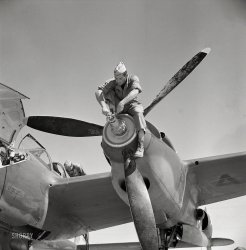
- Mrs. Ostermeyer: 1936
- ... Iowa." View full size. 35mm nitrate negative by Russell Lee.
I miss my grandmother's hands. Mrs. Ostermeyer's hands remind ... Posted by Dave - 09/09/2011 - 6:33pm -

- Archer Mercantile: 1937
- ... Sheridan County, Montana." Medium format negative by Russell Lee for the Farm Security Administration. View full size.
Modest, ... on Walmart.
(The Gallery, Frontier Life, Gas Stations, Russell Lee, Small Towns, Stores & Markets) ... Posted by Dave - 06/23/2019 - 5:48pm -
![Archer Mercantile: 1937 November 1937. "Store building at Alger [i.e. Archer], Sheridan County, Montana." Medium format negative by Russell Lee for the Farm Security Administration. View full size.
Modest, isolated livesMany of the photos to be found on this website show a rural America of modest means in isolated environments. I suspect a Sear catalog was their only contact with the "outside" world.
Perhaps WWII was as much a cultural change as an economic or political force. And this was life not long before many of us were born.
Just wondering.
WhitmarshCall me crazy, but I read nightmarish. And isn’t that Prince Albert in a can behind the door insulated with cardboard?
Gone but also forgottenNeither Alger nor Archer appears on Google Maps, nor on the list of towns and ghost towns for Sheridan County: https://en.wikipedia.org/wiki/Sheridan_County,_Montana#Communities
[Au contraire. -Dave]
I believe that the metropolis of Archer MontanaIs fresh out of mercantile. And maybe a while before another shipment arrives.
Gasoline PumpsThe early gasoline pump on the right being looked down upon by the modern version is classic.
Out of businessNot every small town that gets shut down can blame it on Walmart.
(The Gallery, Frontier Life, Gas Stations, Russell Lee, Small Towns, Stores & Markets)](https://www.shorpy.com/files/images/SHORPY-8b20114a.thumbnail.jpg)
- Flood Refugees: 1937
- ... in tent at Tent City near Shawneetown, Illinois." Photo by Russell Lee for the Resettlement Administration. View full size.
It'll ... Posted by Dave - 12/02/2012 - 8:51am -
![Flood Refugees: 1937 April 1937. "Flood refugee family in tent at Tent City near Shawneetown, Illinois." Photo by Russell Lee for the Resettlement Administration. View full size.
It'll never happenNo matter how long they watch it, that pot will never boil.
Sewing machineThe treadle sewing machine behind the boys seated on the floor has features typical of models from the earlier part of the century (1900-1920); curved drawers and a drop-down head. When the hinged top was opened, a cable lift mechanism raised both the machine and front panel, to allow access for the operator's legs. Nearly every household had a sewing machine, which means that there were millions produced, and that their value today is negligible.
Castor Oil?It looks like the bottle next to the Pet canned Milk might be Puretest Castor Oil.
Worth A Pretty PennyA few items that would be of value today would be the sewing machine cabinet (holding the clock and lamp) and the Mickey Mouse shirt the little boy is wearing.
Sewing Machine?Is that a sewing machine behind the two boys? I think so... it is interesting what people look to save when the flooding begins.
[Fancier than my mother's of similar vintage, interestingly. She was still using hers up into the 1970s. - tterrace]
TreadleMy mother had one of those treadle sewing machines that very much resembled the one in the picture. I liked to sneak in and work the treadle by hand.
Let there be musicThere's also a cabinet Victrola in the right hand side of the photo next to the sewing machine.
Important ThingsIs that a toy motorcycle on the floor to the mother's right? The youngest has a doll. And mother saved her sewing machine (a major investment and a tool for further savings by making things). Today, after the family members, what would we save? Photo albums? Computer disks with photos?
Sunday FunniesRemember when the Sunday comics were this size instead of the present miniaturized version?
Free Sewing MachineThat treadle is a “The Free” Sewing Machine, made in Rockford IL. The cabinet is unique to them. They cost around $65 new, and are exceptionally well engineered. The cabinet top has an automatic lift that raises the machine. Free also had an guarantee that gave the original owner a brand new replacement if the machine was destroyed by fire, flood, or accident. It’s no surprise to see it saved as a prized possession. The machines are a favorite with collectors and quilters today.
(The Gallery, Fires, Floods etc., Kids, Russell Lee)](https://www.shorpy.com/files/images/SHORPY_8b30304a.thumbnail.jpg)
- A Reminder: 1939
- ... 1939. "Sign, Harlingen, Texas." 35mm nitrate negative by Russell Lee for the Farm Security Administration. View full size.
Let the ... Posted by Dave - 04/13/2010 - 10:01am -

- Tire Service: 1942
- ... Mosher Tire, next door to the Dix Hotel. Photo by Russell Lee for the Office of War Information. View full size.
Topper ... Posted by Dave - 09/01/2015 - 11:04am -
![Tire Service: 1942 1942. "Hollywood, California. Tire service station." Mosher Tire, next door to the Dix Hotel. Photo by Russell Lee for the Office of War Information. View full size.
TopperSomething older is parked at the curb to the right of the frame and it appears to have a So Cal AAA license plate topper attached to it!
DeluxeNice 1938 ford Deluxe Tudor sedan parked in front of the bargain rack. I have a '38 Standard Tudor...but not that nice.
Don't bump your head3rd floor room/special rate.
Draft registrationMr. Mosher would be registering for World War I not World War II. His age was 57 in 1942.
[Age requirement for WWII draft registration was 18-64. -tterrace]
I stand corrected. Thanks tterrace as I dropped the ball you picked it up.
MotorolaMotorola was the big name - if not the only one - in auto radios at that time. The company had a large stock of auto radios at the war's beginning. Since auto manufacturing was suspended for the duration of the war, Motorola sold "chairside" radios, which were auto radios converted to 110-volt AC power and installed into end tables.
Rubber RoomsToo bad the tiny top floor room doesn't provide a view of all those luscious, war-rationed tires.
Still going in 1968... according this post in a forum discussion. It says:
"The founder of Mosher Tire Service was Lewis Dean Mosher, born in Illinois on September 26, 1885. His obituary says he was a pioneer in North Hollywood beginning in 1927 and that he had founded his tire business in Los Angeles in 1905 . . . When he filled out a draft registration for WWII he . . . lists his business address as 1534 N. Cahuenga Bl, North Hollywood."
Ah, those daysWhen a half a dozen sizes fit ALL cars. Today, it seems tire shops must have hundreds of sizes, let alone brands.
Part of my family history!This is where my grandfather, Lewis Dean Mosher worked. Later in 1942 the business moved to 12117 Burbank Blvd in North Hollywood. My father and my uncle ended up working together with my grandfather for some time. Eventually my dad, Merrill D. Mosher operated it until he retired. The original structure on Burbank Blvd is no longer there, but the house next door, where my grandparents lived starting in 1927, is still there.
Here is an earlier image, probably taken in 1937.
(The Gallery, Cars, Trucks, Buses, Los Angeles, Russell Lee)](https://www.shorpy.com/files/images/SHORPY-8d28160a.thumbnail.jpg)
- Family Porchrait: 1939
- ... "Husband and wife on porch of farm house." Photo by Russell Lee, Farm Security Administration. View full size.
New Home Ownership ... Posted by Dave - 06/24/2012 - 12:53pm -
![Family Porchrait: 1939 January 1939. Chicot Farms, Arkansas. "Husband and wife on porch of farm house." Photo by Russell Lee, Farm Security Administration. View full size.
New Home OwnershipI can feel the pride they have showing off their new home; all white and pretty. Are those some kind of manufacturer stickers on the window panes? You know, like Minnie Pearl's hat with price tag still attached.
Ma & Pa KettleAnd from the looks of that ax, Joan Crawford is probably lurking somewhere nearby.
Christmas lights?Those "stickers" in the window look like Christmas lights (which would be somewhat appropriate since it's January). It's hard to tell if they're really lights or just stickers.
Okay, I'm going with Christmas light stickers.
Just mucking aroundBesides fishing, you'd need the boots when doing the chores such as feeding the hogs or mucking out the stable. You wouldn't want to be stepping in that stuff with regular shoes. Also, Ms Hen might not be ready to meet her demise. On family farms, it would be the poorest layers who'd meet their doom first.
Uniroyal, Red Ball or LaCrosse?No signs of fishing equipment in the scene, so I wonder - why the hip boots?
Ms. Hen in the left background may be the guest of honor for that chopping block.
[I truly love old farm scenes.]
ElectricityIf these folks didn't have power for a radio, they probably didn't have power for Christmas lights.
Chopping blockBlock could most certainly be used on ms hen's neck, however, the block was most likely for chopping firewood.
A hatchet for the hen, an ax for the wood.
Hip BootsI have no idea why he's wearing those boots, but to SJBill's comment about fishing, it seems that Chicot Farms was/is located on Chicot Lake.
Boots on the groundBoot are a must have on a farm. Animal muck everywhere. I wore mine all the time. No worries and when you are done you can spray them with the hose before you take them off.
I tell young friends that my Mother didn't live in an electrified house until she was 20 and moved to Atlanta. They are dumb-founded. Rural electrification was a great thing. The electric company's would never have done it. To few customers to justify the lines.
Also, great dog!
Dawg on the left"I smell a cat around here somewhere..."
(The Gallery, Cats, Dogs, Russell Lee)](https://www.shorpy.com/files/images/SHORPY_8a24942a.thumbnail.jpg)
- Blueberry Girl: 1937
- ... Minnesota." View full size. 35mm nitrate negative by Russell Lee for the FSA.
Blueberries.... Many thanks for sharing this photo ~ ... Posted by Dave - 04/09/2008 - 8:57pm -
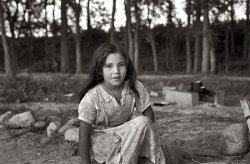
- Thrilling and Popular: 1939
- ... We'll take one of each, please. 35mm nitrate negative by Russell Lee. View full size.
Pulps I collect pulp magazines and to see a ... Posted by Dave - 08/04/2014 - 2:59pm -
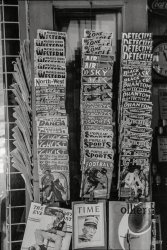
- A Bumper Crop: 1940
- ... which opened the Fat Stock Show." Acetate negative by Russell Lee for the Farm Security Administration. View full size.
Dapper dad ... Posted by Dave - 07/15/2021 - 2:18pm -
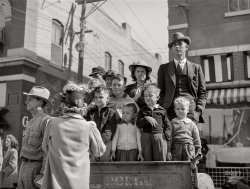
- String Section: c. 1939
- ... a square dance in McIntosh County, Oklahoma. Photograph by Russell Lee for the Farm Security Administration Office of War Information, c. 1939. ... Posted by Ken - 09/08/2011 - 6:33pm -
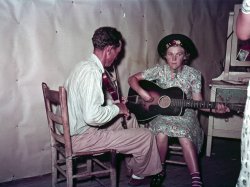
- The Greatest Thing: 1939
- ... at bakery. San Angelo, Texas." Medium format negative by Russell Lee for the Farm Security Administration. View full size.
Long lasting ... Posted by Dave - 06/03/2018 - 6:47pm -
![The Greatest Thing: 1939 November 1939. "Slicing bread at bakery. San Angelo, Texas." Medium format negative by Russell Lee for the Farm Security Administration. View full size.
Long lasting techThat slicer uses the same type of slicing blades as the new machine in my local bakery. The new one has added safety features, of course. I guess it was a great thing!
Not Done YetThis bread slicer looks exactly the same as the one at our local supermarket, Dorothy Lane.
It is a specialty store with the best homemade bread and the bread slicer looks just like this one.
Ok, just can't resist this!
I wonder how much DOUGH this guy makes at his job? Hope he isn't too CRUSTY after a hard day's work. Well at least this photo is a look at a SLICE of pre WWII life.
No loafing, but no gloves hereYep, he's putting his bare hands onto each sliced loaf. And he has enough grease in his hair to lubricate the machine if it starts to seize up.
Been Around a WhileOliver is the same brand of slicing machine I see used in Panera today.
Greatest Title Too!I literally laughed out loud. Well done.
[Please, no applause. Just throw money! - Dave]
Greatest Thing?... since Betty White, maybe.
Cutting UpThe greatest thing? "Preslicely" what I was thinking!
Rock SlicerI KNEW I'd seen one of those machines before.
Here's an Oliver bread slicer being operated by an Alcatraz convict in the penitentiary kitchen circa 1945.
What A Historic FigureBut I thought Oliver Crumbwell was a person.
Anyways, I was just thinking about this the past week. Hearing the saying so much, I was thinking about how did they go about slicing it and exactly how excited people were to get bread you didn't have to slice yourself anymore, this photo cures my curiosity and confirms my suspicion.
"Oliver"So called because it's more grueling.
Oliver Machinery Co.Still in business, it started in Grand Rapids building high quality woodworking tools. After about 100 years of ownership by the Oliver family, it was sold.
(The Gallery, Russell Lee)](https://www.shorpy.com/files/images/SHORPY-8b23569a.thumbnail.jpg)
- The Rookery: 1938
- ... Now occupied by photographers Interesting to learn that Russell Lee also photographed this house. Too bad it's no longer available.
... Posted by Dave - 08/30/2012 - 11:03am -
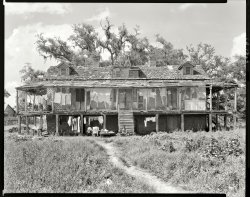
- The Zero Door: 1937
- ... Des Lacs, North Dakota." Medium format negative by Russell Lee for the Farm Security Administration. View full size.
Search ... Posted by Dave - 10/22/2017 - 4:48pm -
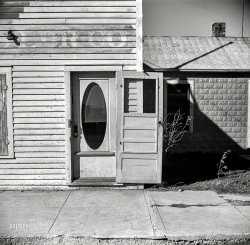
- Coke and a Burger: 1938
- ... Louisiana." View full size. 35mm nitrate negative by Russell Lee for the Farm Security Administration. You want fries with that?
Ella ... Posted by Dave - 06/03/2008 - 9:59am -
![Coke and a Burger: 1938 October 1938. "Making hamburgers in the concession stand at the National Rice Festival. Crowley, Louisiana." View full size. 35mm nitrate negative by Russell Lee for the Farm Security Administration. You want fries with that?
Ella CindersElla Cinders was a daily comic strip that ran from 1925 to 1961. It spawned a movie and a short-lived comic book series, which the advertisement is probably promoting. Just the thing to read with a "Tasty" Coca-Cola or a "Twice as Good" RC. The movie advertised in the back is Spawn of the North.
[The ad is for Pan-Am motor oil. - Dave]
Ella CindersYou can see a good number of Ella Cinders strips at Barnacle Press.
Here.
Pan-Am Motor OilPan-Am was the Louisiana arm of American Oil Company, which in turn was owned by Standard Oil of Indiana. It went by the name Amoco until it merged with BP. Louisiana's native Standard Oil of Louisiana was wholly owned by Standard Oil of New Jersey, Esso, which is now ExxonMobil.
The MoviesTo our left of the Pan-Am Oil sign is a pretty large ad for the movie "Spawn of the North" (1938) starring George Raft, Henry Fonda and Dorothy Lamour - none of whose names is on the part of the poster that we can see. What is on the poster (and readable) are the names Akim Tamiroff, Barrymore,Platt, and Overman. They would be John Barrymore, Louise Platt and Lynne Overman. The movie is the exciting tale of two friends caught on either side of a conflict in the Alaskan salmon fishery. One of the roles that Raft didn't turn down.
(The Gallery, Eateries & Bars, Russell Lee)](https://www.shorpy.com/files/images/8a23967u_0.thumbnail.jpg)























